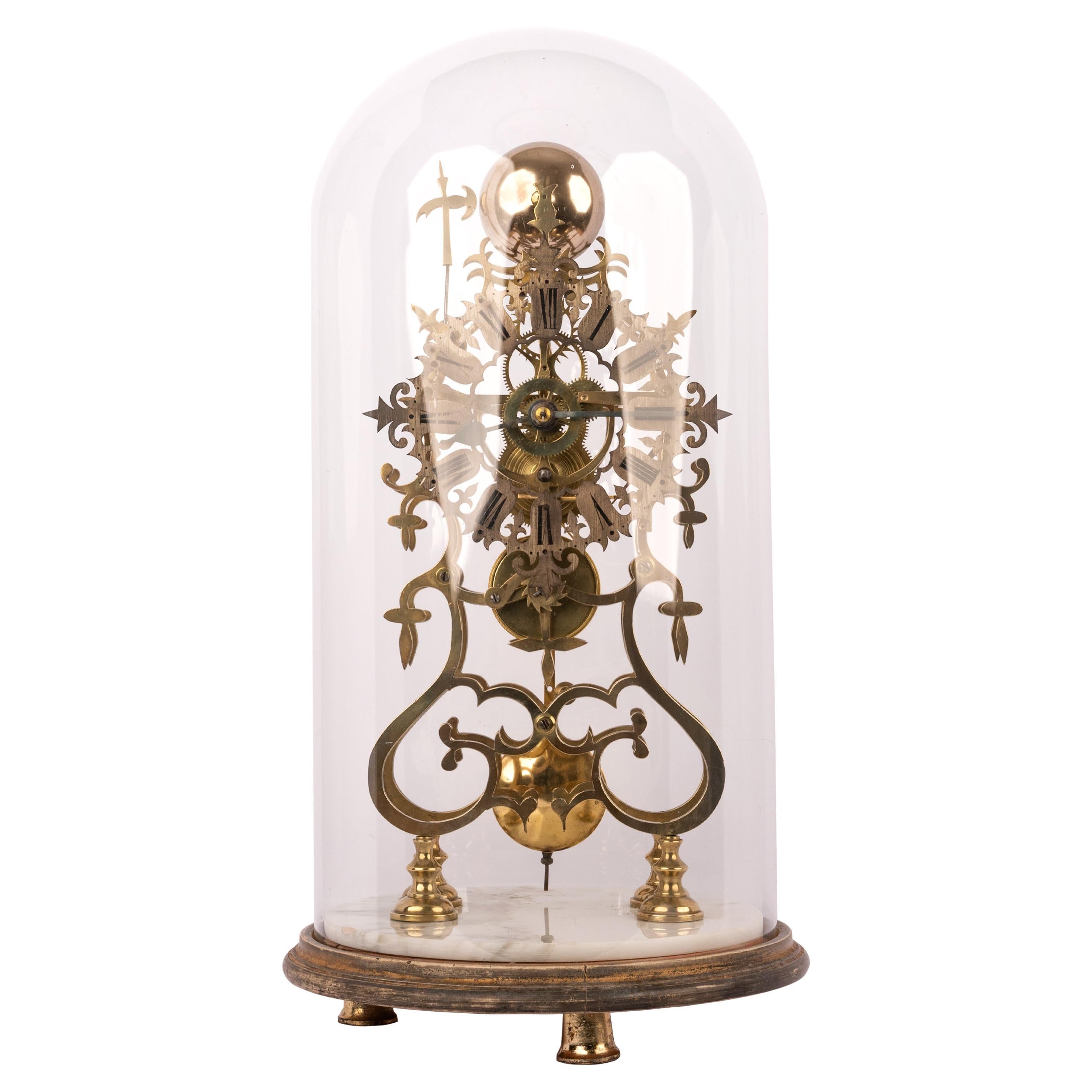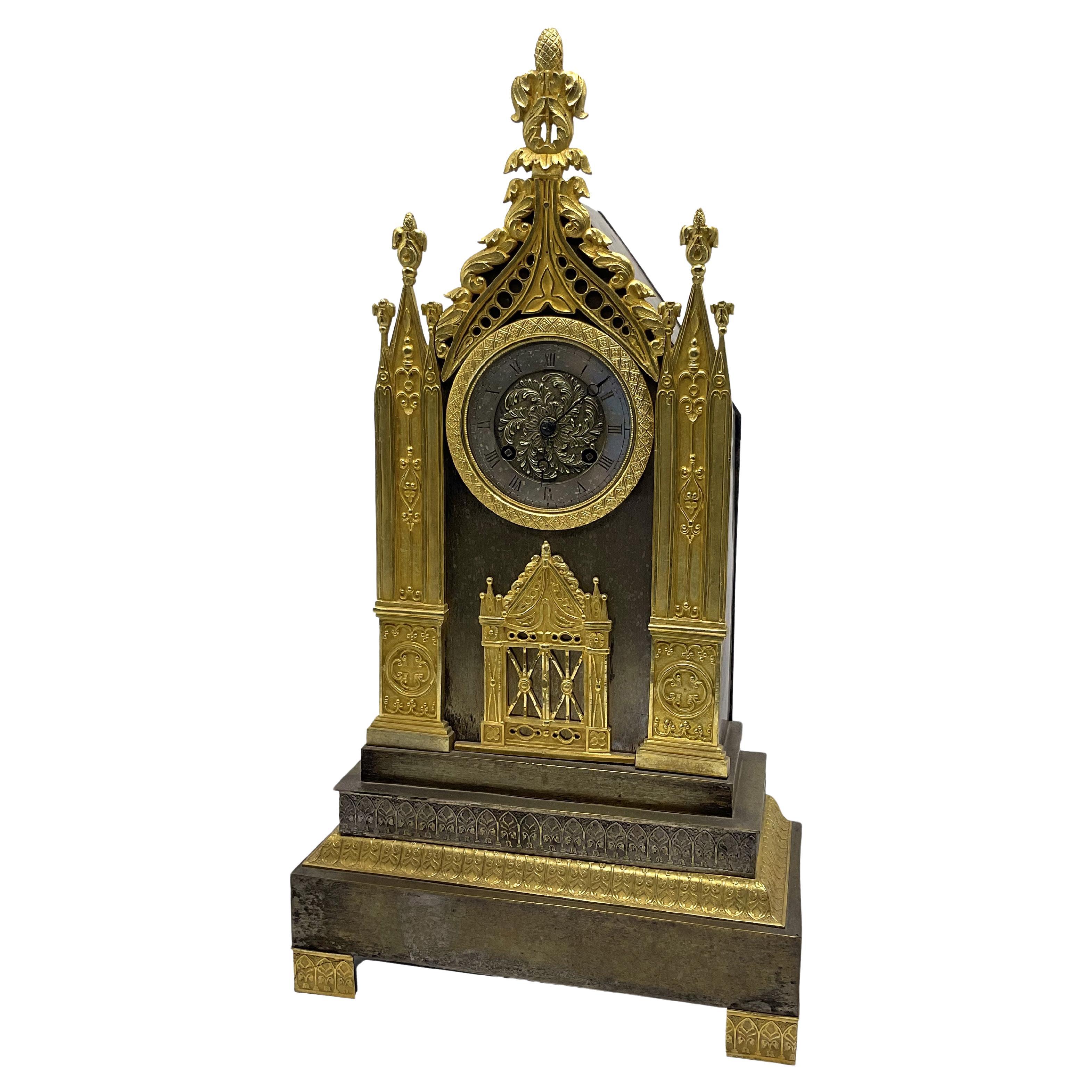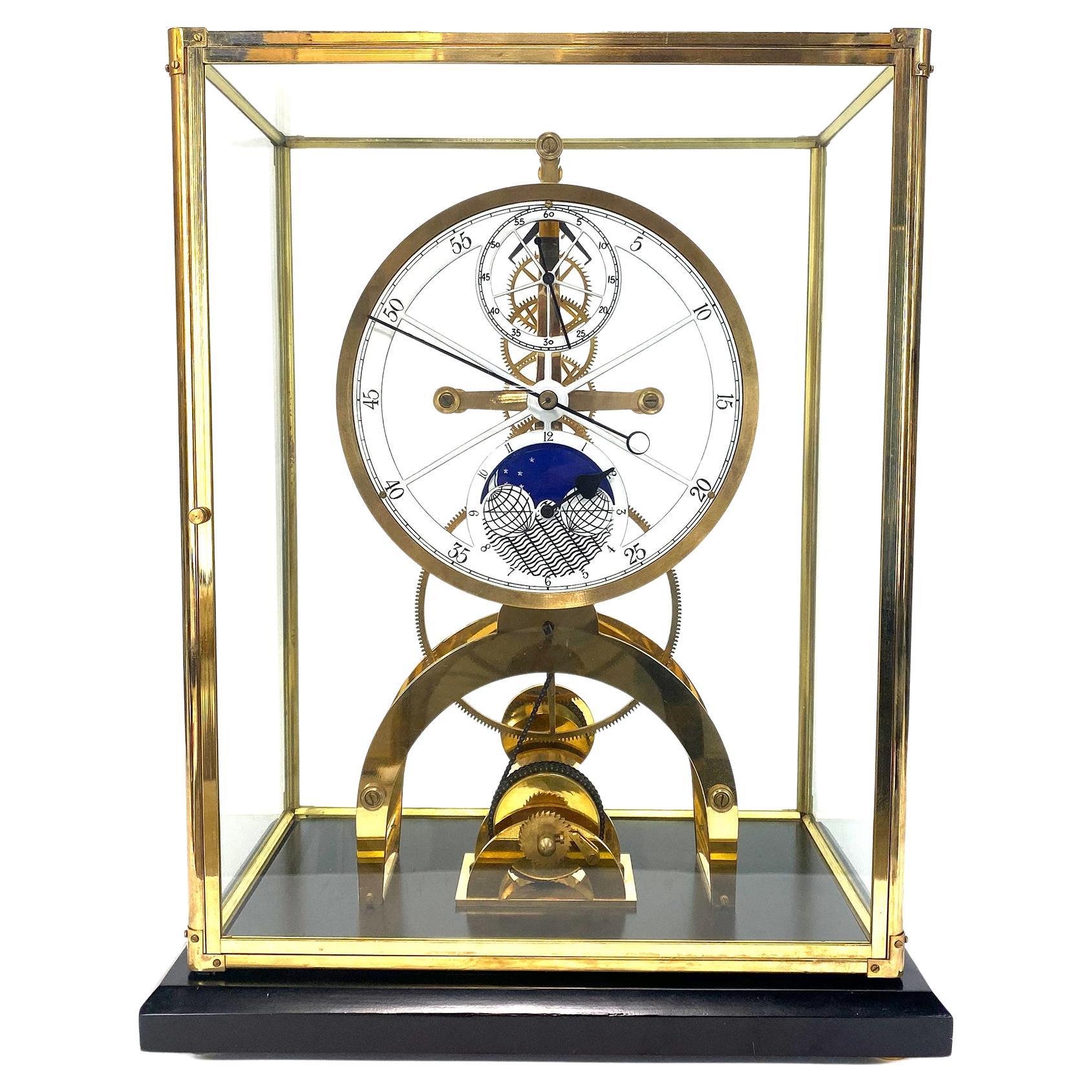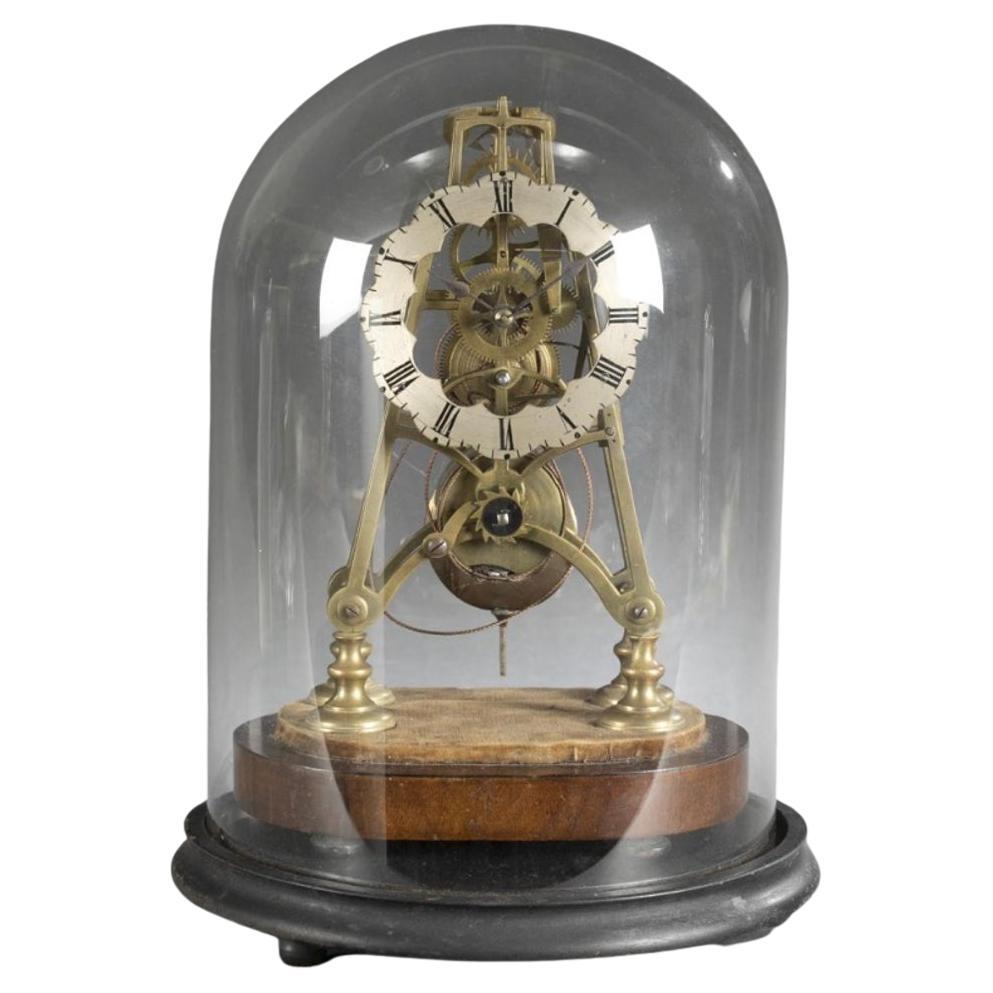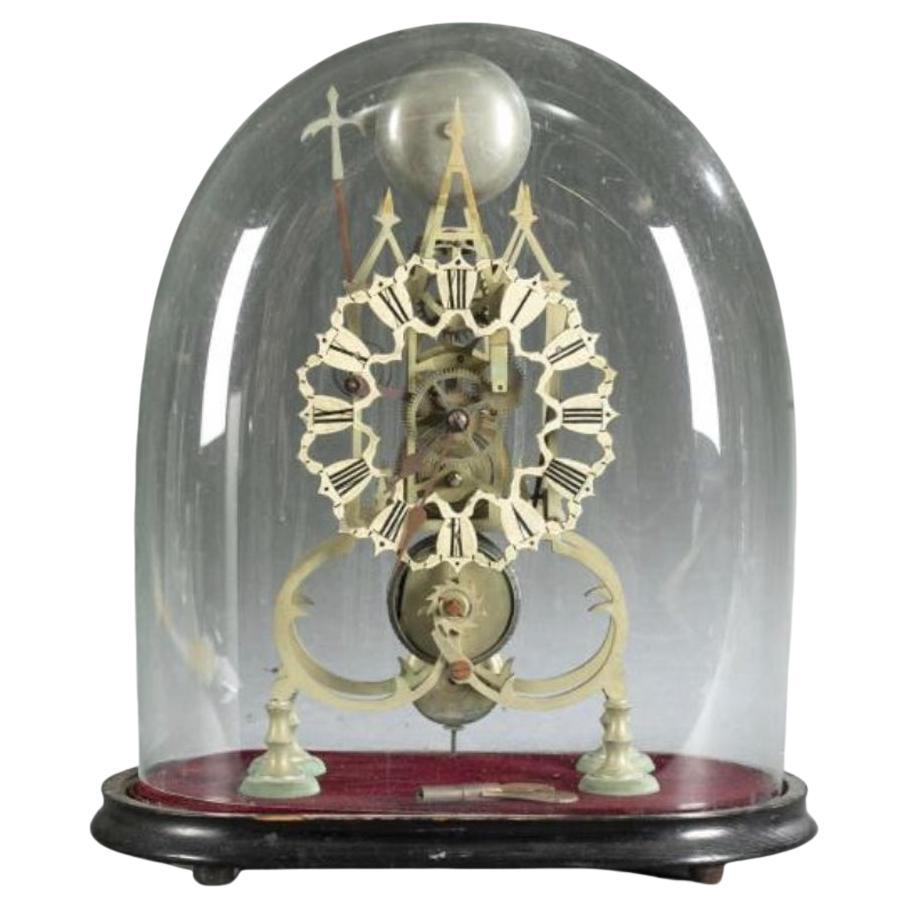Items Similar to Antique English 19th Century 8 Day Fusee Skeleton Cathedral Glass Dome Clock
Want more images or videos?
Request additional images or videos from the seller
1 of 11
Antique English 19th Century 8 Day Fusee Skeleton Cathedral Glass Dome Clock
About the Item
Antique mid 19th century 8 day skeleton clock. Centrally mounted on wood base featuring exposed Fusee movement and protected from dust by a glass dome.
- Dimensions:Height: 13 in (33.02 cm)Diameter: 9 in (22.86 cm)
- Style:Victorian (Of the Period)
- Materials and Techniques:
- Period:
- Date of Manufacture:Mid-19th Century
- Condition:Wear consistent with age and use. Good antique condition, wear and distressing commensurate with age and use, tarnish, split to wood, working, original.
- Seller Location:Dayton, OH
- Reference Number:
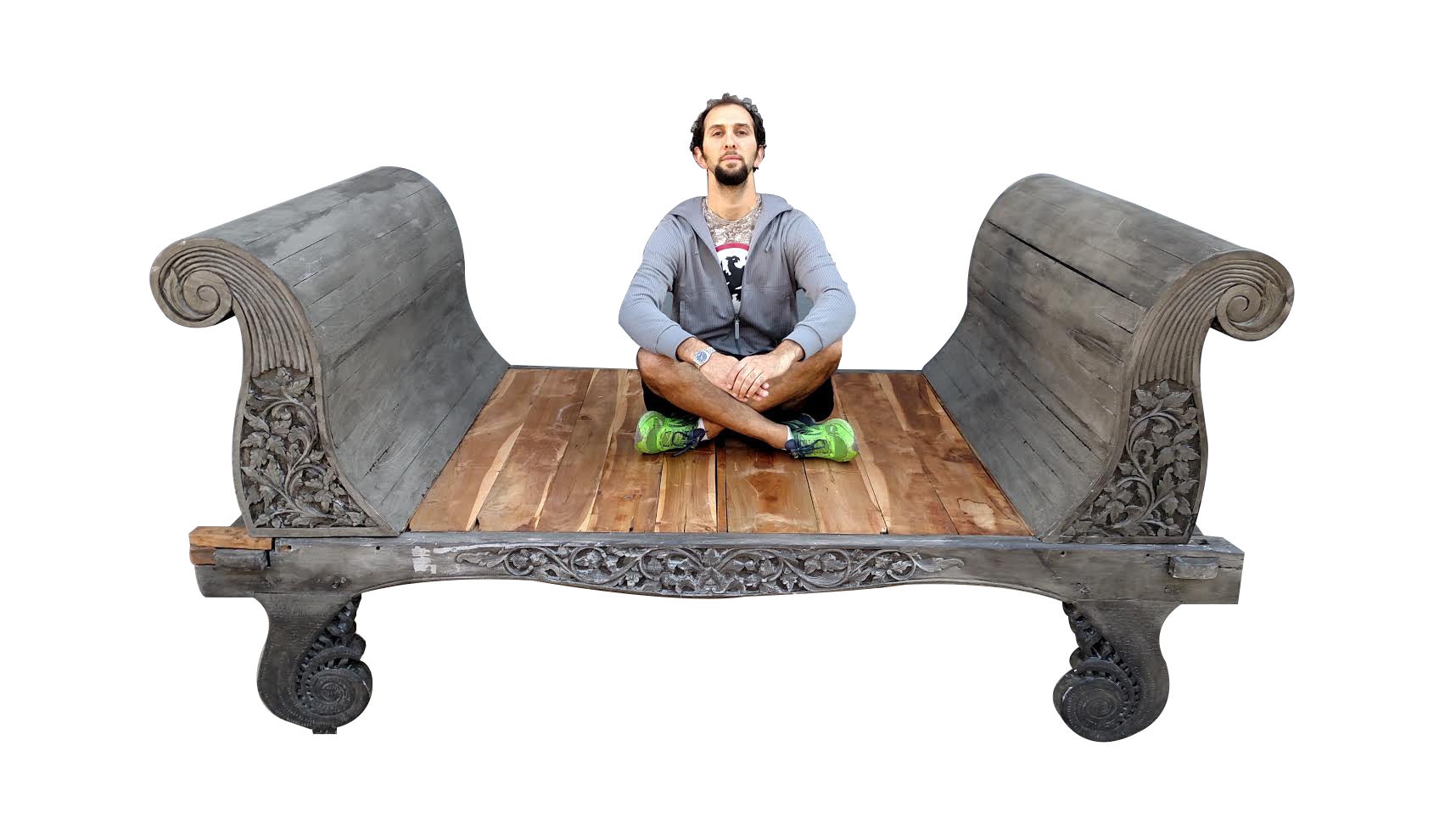
About the Seller
4.9
Platinum Seller
These expertly vetted sellers are 1stDibs' most experienced sellers and are rated highest by our customers.
Established in 2010
1stDibs seller since 2020
1,121 sales on 1stDibs
Typical response time: <1 hour
- ShippingRetrieving quote...Ships From: Dayton, OH
- Return PolicyA return for this item may be initiated within 2 days of delivery.
More From This SellerView All
- Antique 19th Century French AD Mougin Gilt Bronze Mantel Garniture Clock & UrnsBy A.D. MouginLocated in Dayton, OH"Antique AD Mougin French figural garniture clock and mantel urns. Made of marble and bronze with gilt accents and neoclassical styling featuring a figural b...Category
Antique Late 19th Century French Provincial Garniture
MaterialsMarble, Bronze
- Antique French 19th C Japy Fil Classical Figure Bronze Slate Marble Mantel ClockBy Japy FrèresLocated in Dayton, OHA beautiful 19th Century French Mantel Clock. Features a seated woman in the thinker position. She is wearing a large flowing dress, sitting on a Klismos chair with footed raised ove...Category
Antique Late 19th Century French Provincial Mantel Clocks
MaterialsSlate, Bronze
- 18th C. English Pine Curtis & Horspool London Act of Parliament Tavern ClockLocated in Dayton, OH"18th century monumental museum quality Act of Parlament clock. Made from pine with a large round face over elongated case. Features an enameled metal face marked Curis Horspool in Leicester, London England. Curis was the royal watchmaker of the Prince of Wales. As a result of an Act passed by the English Parliament in 1797 tavern clocks were hung in every pub and tavern throughout the British Isles. The Act declared that a tax would be collected on every clock in the realm. As a result many private clock owners either hid their clocks or got rid of them altogether. Thus taverns and pubs became the preferred location for obtaining the correct time. The Tavern owners did not mind paying the tax because the towns people had to stop by if they wanted to find out what time it was. This resulted in more people eating and drinking at the Tavern. An ""Act of Parliament clock...Category
Antique 18th Century British Colonial Wall Clocks
MaterialsPine
- Antique 19th C. English Staffordshire Porcelain Poodle Spaniels Clock FigurineLocated in Dayton, OHAntique 19th century Staffordshire porcelain figurine featuring a faux clock flanked by a pair of seated King Charles Spaniels and topped with a standing...Category
Antique 19th Century Victorian Animal Sculptures
MaterialsPorcelain
- Rare Self Winding Clock Co Naval Observatory Time Western Union Wall Clock 26"By Self Winding Clock Co.Located in Dayton, OHAntique Western Union, Naval Observatory Time, self winding clock. Features a tall wooden case with carved corners and pediment mounted with tin sign reading "Naval Observatory Time Hourly By Western Union. White metal face with black Roman numerals and hands. Interior of case labeled "Property of Self-Winging Clock Co New York" and serial number on metal tag as well as on works. F Style / Vibrator movement, Serial Number 92630 (likely manufactured before 1917). Patented Oct. 4, 1898 by the Self Winding Clock Company. Fitted with Archer AC Adapter. "The Self Winding Clock Company (SWCC) of New York began business in 1886 marketing their own electro-mechanical clocks based on the 1884 electro-mechanical clock patent of one of the company founders, Chester Pond (1844-1912). The innovative principle of this clock mechanism was the incorporation of a small electric winding motor that automatically rewound the mainspring after the clock ran for one hour. The clocks were powered by batteries. The batteries would last at least one year. By being automatically rewound each hour, the strain on the mechanism was kept to a minimum, resulting in a very accurate timepiece. At about the same time SWCC began selling clocks, Pond was developing an electro-mechanical synchronizer attached to the clock movement that could synchronize the clock hands to an accurate time source. The synchronization occurs when a remote, precisely timed, electrical impulse is sent via wires connected to the individual clocks. By 1887 the synchronizers had been so improved that the Self Winding Clock Company could not only market individual clocks but also sell entire synchronized clock systems. By the 1960’s the days of individual elegant mechanical timepieces and synchronized time systems were over. SWCC ceased operations in the late 1960’s. All company records and inventories were relegated to the trash pile. The STYLE “F”, or as commonly referred to, the VIBRATOR movement was developed by Frederick M. Schmidt in the late 1890’s. By 1898 the “F” movement was being installed in almost all SWCC clocks. The movement has a Graham dead beat escapement. The “F” movement incorporates both the time train and winding motor in one set of plates. The motor used a single pair of coils. It was more reliable and easier to service than the rotary movement. The mainspring is re-wound after running for one hour. The vibrating armature oscillates up and down carrying a winding lever with a pawl that turns the winding wheel. The “F” movement was used in individual clocks and in clocks that were part of synchronized systems. It was made in 60, 80,120 and 140 beat versions. There were virtually no changes to the movement in 60 plus years the movement was in production. Almost all Style “F” movements wound on 3 volts DC. Style “F” movement serial numbers started in the 33,000’s and the first movements were probably made in 1898. The earliest plates had patent dates of 1891, 1892 & 1898. Serial numbers with these patent dates go up to the 63,000’s and were made before 1908. By 1908 the plates only had the 1898 patent date. By using catalog images of movement serial numbers it can be concluded that movements with serial numbers up to 112,000 were made in or before 1917. Movements with serial numbers up to 196,000’s were made in or before 1929. The single patent date serial numbers go as high as 220,000’s. Then there appears to be a large numbering gap. Finally, movements appear with no patent dates and serial numbers with the prefix FR. These numbers start at 300,000 but only continue to about 302,000. Start again at 400,000 and continue to about 402,000. Based on the large serial number gaps, the total number of “F” movements manufactured is probably around 200,000. They were manufactured between 1898 and possibly as late as the 1950’s. SWCC both sold clocks to and partnered with their biggest customer, Western Union in a nationwide distribution of precisely accurate “Naval Observatory Time” clocks. These either 120 or 140 beat Naval Observatory clocks...Category
Early 20th Century Late Victorian Wall Clocks
MaterialsMetal
- Antique German Victorian Mahogany Westminster Kienzle Bracket Mantel ClockBy Kienzle ClocksLocated in Dayton, OHEarly 20th Century Kienzle key wound mantel clock with simple neoclassical mahogany case and floral etched brass face including controls for speed and chime above the clockface. Arab...Category
Early 20th Century Neoclassical Mantel Clocks
MaterialsMahogany
You May Also Like
- Antique 19th Century English 8 Day Fusee Brass & Glass Dome Skeleton Clock, 1870Located in Portland, ORA good & large antique 19th century eight day single fusee skeleton clock, under a glass dome, circa 1870. The clock has just been serviced and overhauled by a clocksmith, the brass...Category
Antique 1870s English Victorian Table Clocks and Desk Clocks
MaterialsMarble, Brass
- English Late 19th Century Skeleton Clock with Oval Glass DomeLocated in Los Angeles, CAEnglish Late 19th Century Skeleton Clock Protected by a Glass Dome.Category
Antique 1890s English Other Table Clocks and Desk Clocks
MaterialsBrass
- Cathedral clock, France, 19th centuryLocated in Spinea, VenetoRare and elegant stand clock from the refined architectural form. Burnished bronze and gilded bronze structure; support structure of rectangular shape with several orders of decorati...Category
Antique 19th Century French Table Clocks and Desk Clocks
MaterialsBronze
- 24k Astro Porcelain Moon Dial 8 Day Fusee Chain Skeleton ClockLocated in Danville, CA24k Astronomical Porcelain dial 8 day Fusee chain Skeleton clock with moon dial Here is a very nice looking 24K plated large skeleton clock, housed inside...Category
Early 2000s Mantel Clocks
MaterialsBrass
- Early 19th Century Continental Brass Skeleton Clock on Wood Base with Glass DomeLocated in Middleburg, VAEarly 19th Century Continental Brass Skeleton Clock on Wood Base with Glass Dome. Silvered chapter ring with Roman numerals. Measurements: Clock -...Category
Antique Early 19th Century English Gothic Table Clocks and Desk Clocks
MaterialsBrass
- Early 19th Century, Gothic Brass Skeleton Clock on Wood Base with Glass DomeLocated in Middleburg, VAEarly 19th century Gothic brass skeleton clock on wood base with glass dome. Bell on peak with steeple design and halberd hammer. Painted metal fa...Category
Antique Early 19th Century English Gothic Table Clocks and Desk Clocks
MaterialsBrass
Recently Viewed
View AllMore Ways To Browse
8 Day
Antique Decorative Table
Glass Dome
Glass Domes
8 Antique Table
Mid Century Glass Antique Table
Doming Table
Antique Glass Dome
Antique Glass Domes
Glass Dome Antique
8 Day Clock Antique Clocks
Antique 8 Day Clocks
8 Day Antique Clock
Antique 8 Day Clock
Cathedral Glass
Antique English Desk 19th Century
Antique English Table Desks
Cathedral Wood
